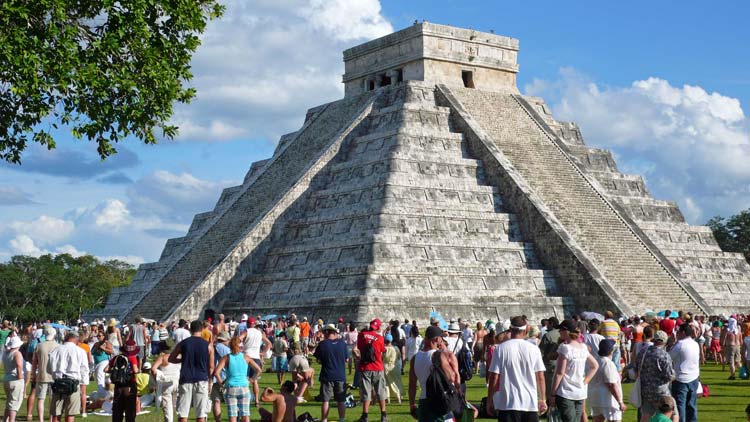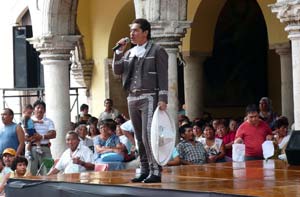Merida: A rich Mayan-Spanish stew
Story and photos by Bob Schulman

Monument in Merida tells history of the Mayans.
The Mayan town of T'ho thrived for centuries out on eastern Mexico's Yucatan Peninsula -- until 1542, when the Spanish conquistadores ran the Mayans off, ripped their city down and built a new one for themselves on the spot. The bearded foreigners called it Merida, after a rich city of the same name in Spain.
After awhile the Mayans started to drift back, at first to work in the fields, ranches and kitchens of the great haciendas of their new Spanish landlords. In the mid-1800s, thousands more came out of the jungle to take jobs on the area's henequen plantations, planted to help meet the world's need for rope and twine (made from fibers of the cactus-like plant). When the debut of synthetic fibers took the wind out of the henequen market in the early 1900s, many of the workers moved into town.

Humberto Gomez gives regional tours.
Today, it's estimated that well over half of Merida's million or so residents speak both Mayan and Spanish, a good number with Mayan as their primary language. Tour guide Humberto Gomez knows every inch of the city. He's been showing visitors around for over a half-century, traipsing up and down the steps of colonial palaces and the grand cathedral, wandering through block-long museums, driving by the swanky mansions of the henequen barons and checking out other landmarks in the city's rich stew of Mayan and Spanish cultures. Merida, he points out, has the country's second largest historic district after Mexico City.
Gomez also takes customers to the famous archaeological sites outside the city. One is the famous Mayan city of Chichen-Itza, about two hours away, where the signature pyramid – one of the New Seven Wonders of the World – is the picture-postcard Temple of Kukulcan. The temple grounds are particularly packed during the two equinoxes when the setting sun creates the shadow of a feathered serpent winding down a staircase of the 365-step pyramid.

Temple of Kukulcan at Chichen Itza.
Gomez himself is something of a legend here. He's recognized as the first man in modern times to see the secrets of Balankanche, a Mayan ceremonial center set in network of enormous caverns. The site, a few miles from Chichen-Itza, was discovered by Gomez in 1959.

Temple of the Magician at Uxmal.
Also among his most popular tours is the magnificent Mayan city of Uxmal. Here, in another eyepopping sight straight off the postcards, the distinctive oval Temple of the Magician (according to legend it was built in a single night) looms over acres of other temples, government buildings, ballcourts and the like. In the evening, the entire city becomes a stage for a spectacular $2 million light and sound show explaining the history of the site. Another must-see spot on Gomez' tour routes is a colonial town full of yellow buildings called Izamal. Its main feature is the 450-year-old Convent of San Antonia de Padua, also painted yellow, which is used at night as the backdrop for the area's third historical light and sound show (Chichen-Itza has one, too).
The tours usually get back to Merida in time for the city's traditional street festivals. You might find crowds watching folkloric dancers on one block, strolling minstrels on another and salsa bands on still another. Hungry? There are lots of food stands around the festivities selling Merida's classic lime soup, suckling pig in pipal sauce, stuffed cheese meringues and other tasty dishes.
Everyone on the people-packed streets (vehicle traffic isn't allowed on certain nights) whoops it up together, locals and tourists alike, playing out a feast for the eyes and the palate that's been going on as long as anyone here can remember.

Sound and light show at Izamal.
But while the Meridian stewpot still boils over with the flavor of its mixed heritage, modern times have added new spices to the gumbo. For example, Volkswagens now mix with “calesa” horsedrawn carriages on the city's cobbled streets, youngsters dressed in hip-hop clothes sip coffee with others in old-time Mayan garb, and bargain-seeking passengers from cruiseliners docked at the nearby port of Progreso periodically flood Merida's shops. And new names such as Costco, Sam's Club, McDonald's and Burger King have popped up around town. Gomez' customers have kept up with the times, too. “I remember when tourists wouldn't dream of going out in anything but suits and long dresses, even during our hot, humid summers,” he recalls. “Today, anything goes.”

Entertainment at a street festival.
Gomez puts group tours together, so you could wind up climbing pyramids with anywhere from a few to a lot of other sightseers. His phone number from the U.S. is 011-52-999-927-1530. In Merida, it's just the last seven numbers.
www.tibesarealty.com.mx
www.tibesarealty.com.mx/wordpress/
 Monument in Merida tells history of the Mayans.
Monument in Merida tells history of the Mayans. Humberto Gomez gives regional tours.
Humberto Gomez gives regional tours. Temple of Kukulcan at Chichen Itza.
Temple of Kukulcan at Chichen Itza. Temple of the Magician at Uxmal.
Temple of the Magician at Uxmal.  Sound and light show at Izamal.
Sound and light show at Izamal. Entertainment at a street festival.
Entertainment at a street festival.
No hay comentarios:
Publicar un comentario